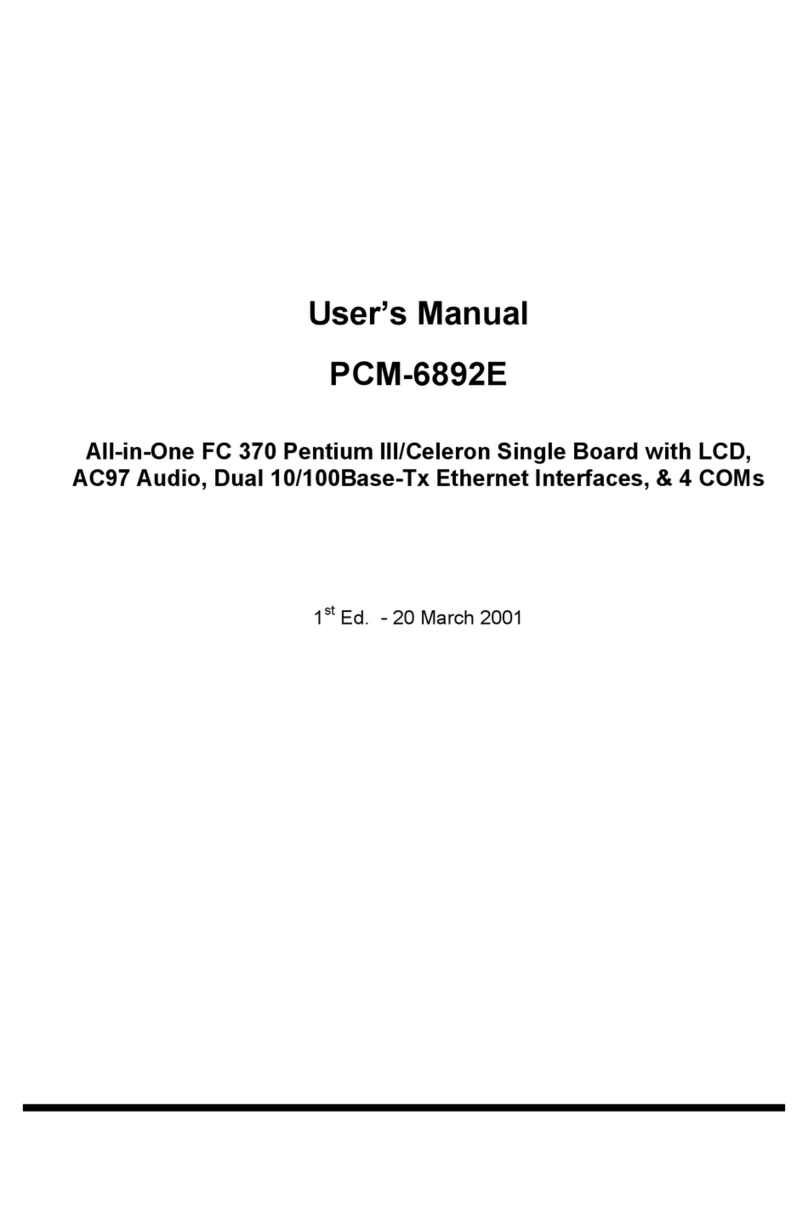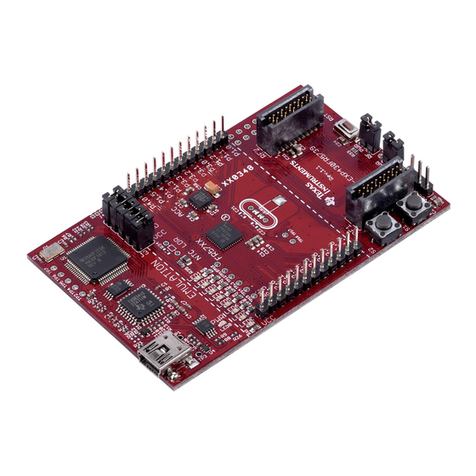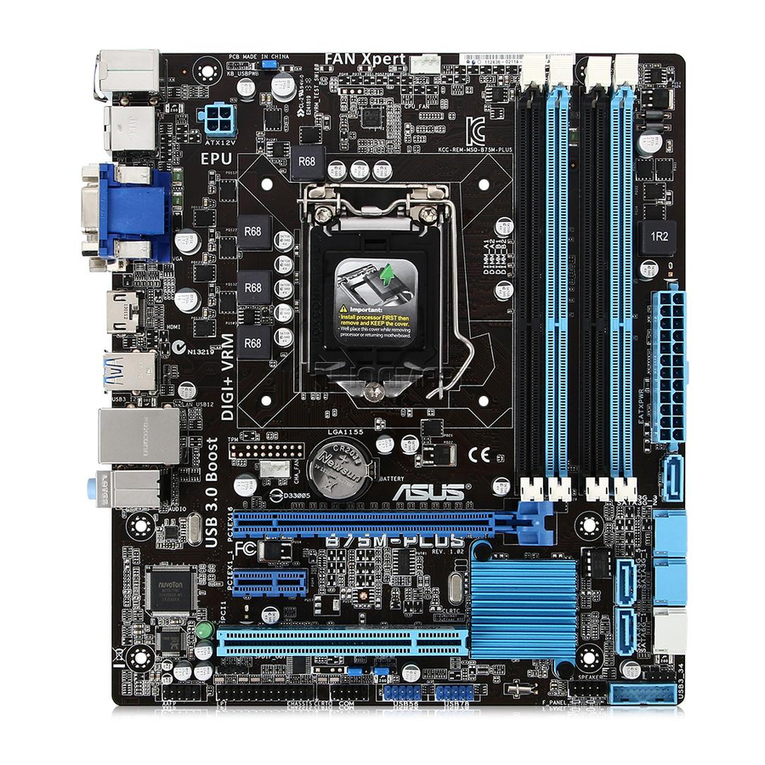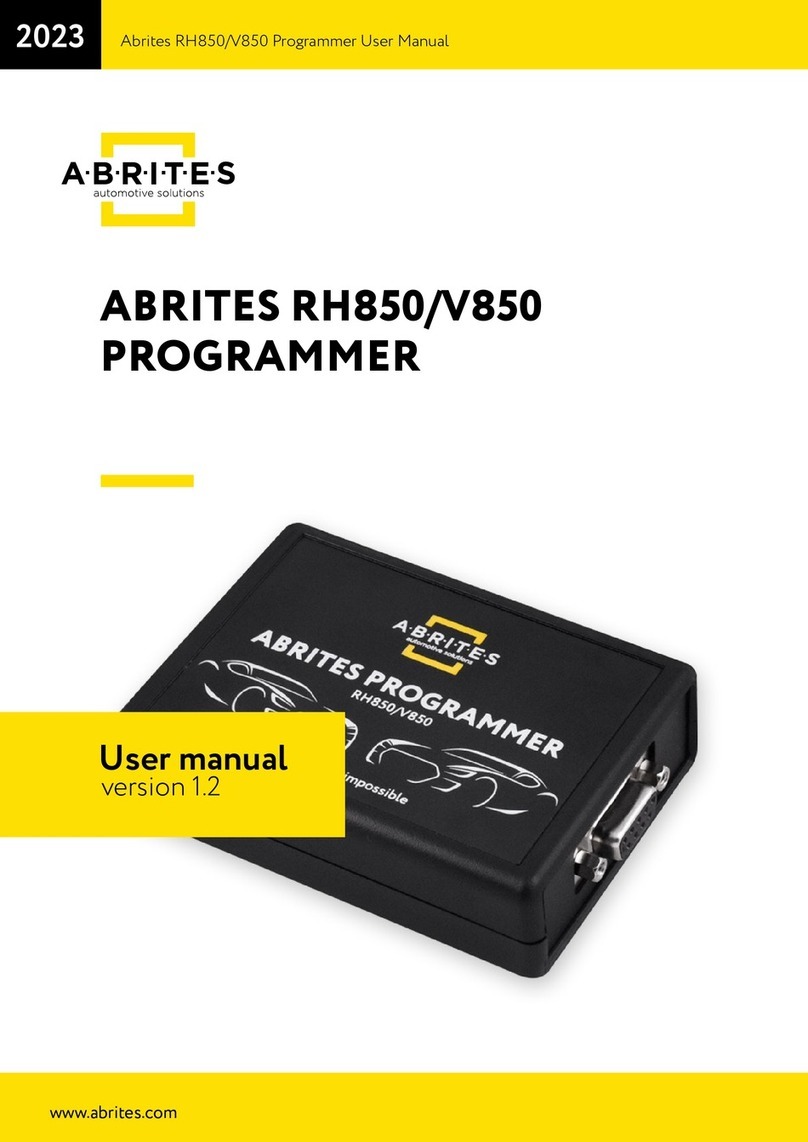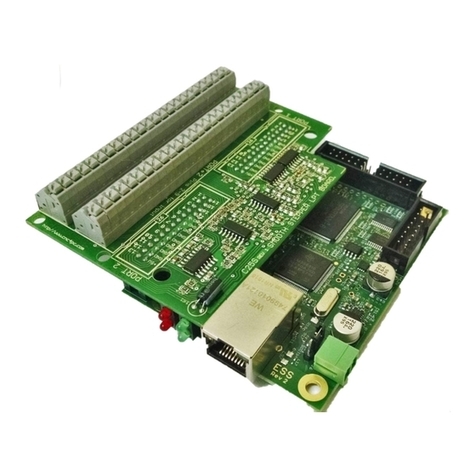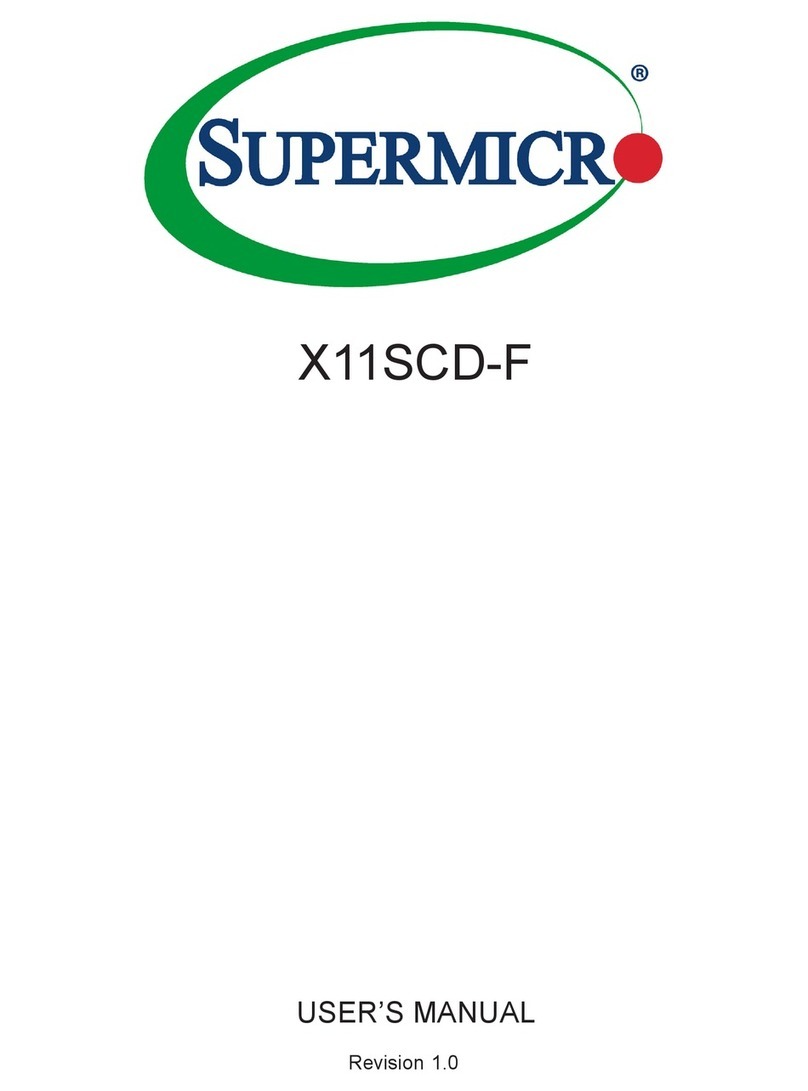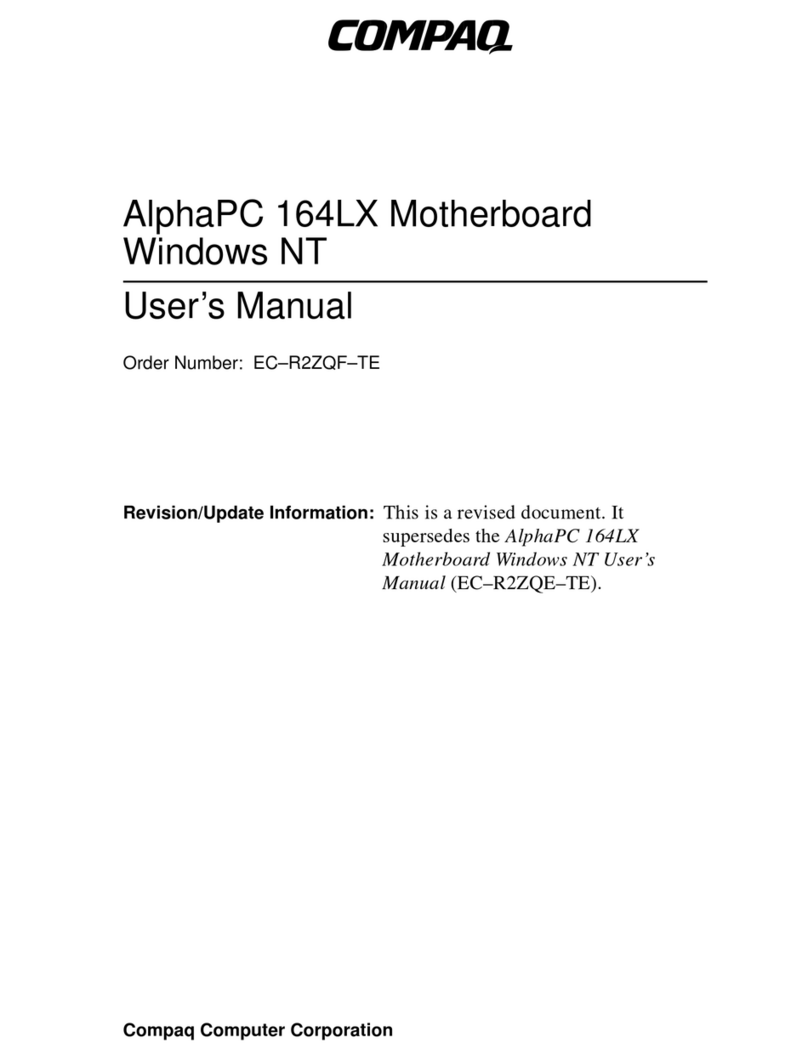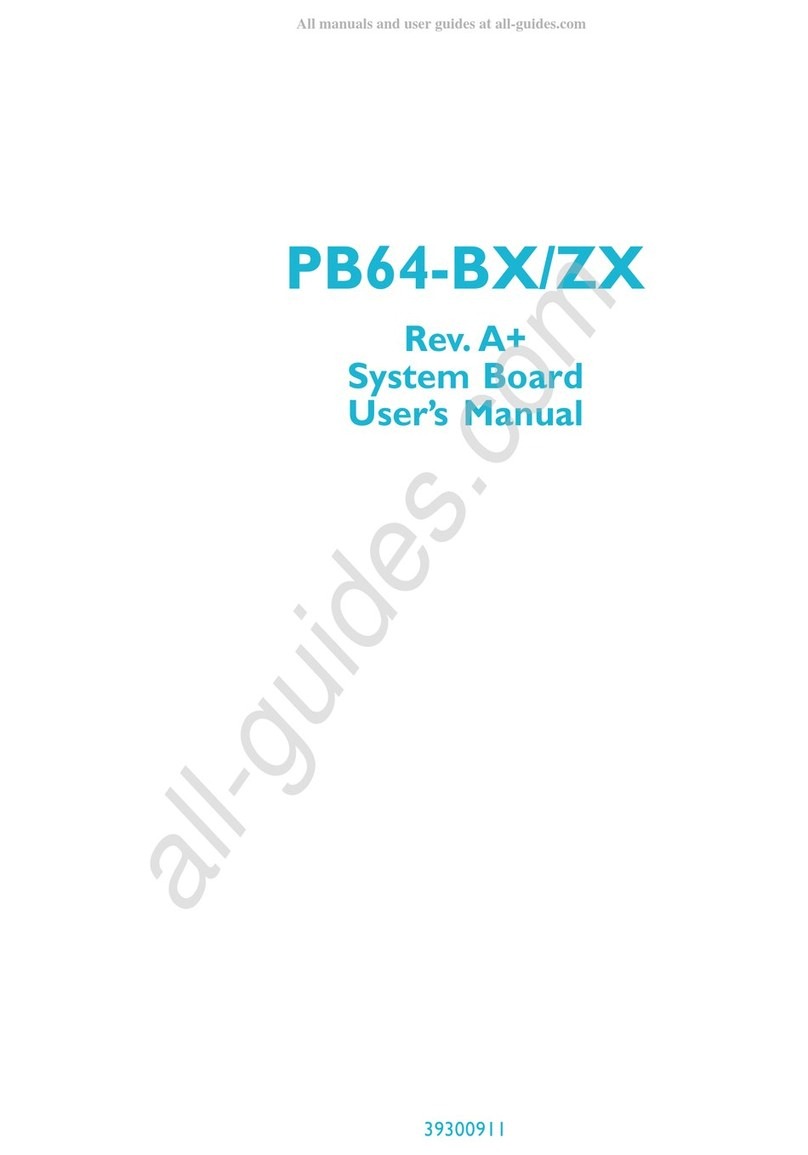EMAC PCA-6003 User manual

PCA-6003
Full-sized socket 370 Intel®
Pentium® III processor-
based PCI/ISA-bus CPU
card

Copyright notice
This document is copyrighted, 2003
All rights are reserved.
No part of this manual may be reproduced, copied, translated or
transmitted in any form or by any means without the prior written
permission. Information provided in this manual
is intended to be accurate and reliable.
Acknowledgements
• AWARD is a trademark of AWARD Software, Inc.
• Intel®and Pentium®III are trademarks of Intel Corporation.
• MS-DOS is a trademark of Microsoft Corporation.
• WinBond is a trademark of Winbond Corporation.
• VIA is a registered trademark of VIA Technologies Inc.
All other product names or trademarks are the properties of their
respective owners.
Part No. 2002600302
3rd Edition Printed in Taiwan May. 2002

A Message to the Customer
Customer services
Each and every product is built to the most exacting
specifications to ensure reliable performance in the harsh and
demanding conditions typical of industrial environments. Whether
your new equipment is destined for the laboratory or the
factory-floor, you can be assured that your product will provide the
reliability and ease of operation for which the name has come to be
known.
Your satisfaction is our primary concern. Here is a guide to
our customer services. To ensure you get the full benefit of
our services, please follow the instructions below carefully.
Technical support
We want you to get the maximum performance from your products. So
if you run into technical difficulties, we are here to help. For the most
frequently asked questions, you can easily find answers in your
product documentation. These answers are normally a lot more
detailed than the ones we can give over the phone.
So please consult this manual first. If you still cannot find the answer,
gather all the information or questions that apply to your problem, and
with the product close at hand, call your dealer. Our dealers are well
trained and ready to give you the support you need to get the most
from your products. In fact, most problems reported are
minor and are able to be easily solved over the phone.
In addition, free technical support is available from EMAC, Inc.'s
engineers every business day. We are always ready to give advice on
application requirements or specific information on the installation and

elbatnosirapmocseireS3006-ACP
ledoM1A00-V3006-ACP1A00-EV3006-ACP1A00-H3006-ACP
:UPC letnI
®
muitneP
®
073tekcoSIII ✓✓ ✓
:tespihcmetsyS T331ELPollopAAIV ✓✓ ✓
:SOIB SOIBhsalFP&PdrawA ✓✓ ✓
:ehcaC2L UPCnoBK215/652/821 ✓✓ ✓
:MARmetsyS.xaM
)stekcosnip-861X2(BG1
✓✓ ✓
troPBSU 22 2
srotcennocEDIE2 ✓✓ ✓
stroplellarap1,laires2 ✓✓ ✓
:AGV AGV/PGA
)ni-tliubtespihC(
✓✓ ✓
:NAL tenrehtET-esaB001/01
)C9318ketlaeR:tespihc(
✕✓ ✓
)evirdhgihASI(ASiH ✕✕ ✓

Product warranty
EMAC, Inc. warrants to you, the original purchaser, that each of its
products will be free from defects in materials and workmanship for two
years from the date of purchase.
This warranty does not apply to any products which have been
repaired or altered by persons other than repair personnel authorized
by EMAC, or which have been subject to misuse, abuse, accident
or improper installation. We assume no liability under the
terms of this warranty as a consequence of such events.
If a product is defective, it will be repaired or replaced at no charge during
the warranty period; after evaluation. For out-of-warranty repairs, you
will be billed according to the cost of replacement materials, service
time and freight. Please consult your dealer for more details.
If you think you have a defective product, follow these steps:
1. Collect all the information about the problem encountered. (For
example, type of PC, CPU speed, our products used, other
hardware and software used, etc.) Note anything abnormal and list
any on-screen messages you get when the problem occurs.
2. Call your dealer and describe the problem. Please have your
manual, product, and any helpful information readily available.
3. If your product is diagnosed as defective, obtain an RMA (return
material authorization) number from your dealer. This allows us to
process your return more quickly.
4. Carefully pack the defective product, a fully-completed Repair and
Replacement Order Card and a photocopy proof of purchase date
(such as your sales receipt) in a shippable container. A product
returned without proof of the purchase date is not eligible for
warranty service.
5. Write the RMA number visibly on the outside of the package and
ship it prepaid to your dealer.

Initial Inspection
Before you begin installing your card, please make sure that the
following materials have been shipped:
• 1 PCA-6003 socket 370 Pentium III®processor-based single board
computer
• 1 Pentium III® processor (optional)
• 1 PCA-6003 startup Manual
• 1 CD driver utility and manual (in PDF format)
• 1 FDD cable, P/N: 1701340703
• 2 UDMA 66/100 HDD cables, P/N: 1701400452
• 1 printer (parallel port) cable & COM port cable kit, P/N: 1700060305
• 1 ivory cable for PS/2 keyboard and PS/2 mouse, P/N: 1700060202
• 1 USB cable (optional), P/N 1700100170
If any of these items are missing or damaged, contact your distributor
We have carefully inspected the PCA-6003 mechanically and
electrically before shipment. It should be free of marks and scratches
and in perfect working order upon receipt.
As you unpack the PCA-6003, check it for signs of shipping damage.
(For example, damaged box, scratches, dents, etc.) If it is damaged or it
fails to meet the specifications, notify our service department or your
local sales representative immediately. Also notify the carrier. Retain
the shipping carton and packing material for inspection by the carrier.
After inspection, we will make arrangements to repair or replace the
unit.

Content
Chapter 1 Hardware Configuration ............................... 1
1.1 Introduction .......................................................................... 2
1.2 Features................................................................................. 3
1.3 Specifications ........................................................................ 5
1.3.1 System .........................................................................5
1.3.2 Memory .......................................................................5
1.3.3 Input/Output ................................................................6
1.3.4 VGA interface ............................................................. 6
1.3.5 Ethernet LAN ............................................................. 6
1.3.7 Industrial features ........................................................ 6
1.3.8 Mechanical and environmental specifications .............7
1.4 Board Layout: Main Features ........................................... 8
1.5 Jumpers and Connectors .................................................... 9
1.6 Board Layout: Jumper and Connector Locations ........ 11
1.7 Safety Precautions .............................................................. 12
1.8 Jumper Settings ................................................................. 13
1.8.1 How to set jumpers ................................................... 13
1.8.2 CMOS clear (J1) ....................................................... 14
1.8.3 Watchdog timer output (J2) ...................................... 14
1.9 System Memory ................................................................. 15
1.9.1 Sample calculation: DIMM memory capacity ........... 15
1.9.2 Supplementary information about DIMMs ................ 16
1.10 Memory Installation Procedures .................................. 16
1.11 Cache Memory ................................................................. 16
1.12 CPU Installation ............................................................... 17
Chapter 2 Connecting Peripherals ............................. 19
2.1 Primary (CN1) and Secondary (CN2) IDE Connectors 20
2.2 Floppy Drive Connector (CN3) ....................................... 21
2.3 Parallel Port (CN4) ............................................................ 21
2.4 USB Port (CN6) ................................................................. 22

2.5 VGA Connector (CN7) ...................................................... 22
2.6 10/100Base-T Ethernet Connector (CN8) .................... 23
2.7 Serial Ports (CN9: COM1; CN10: COM2) ................... 23
2.8 PS/2 Keyboard and Mouse Connector (CN11) ............. 24
2.9 External Keyboard Connector (CN12) .......................... 24
2.10 Infrared (IR) Connector (CN13) ................................... 25
2.11 CPU Fan Connector (CN14) .......................................... 25
2.12 Front Panel Connectors (CN16, CN17, CN18, CN19,
CN21 and CN29) ...................................................................... 26
2.12.1 Keyboard lock and power LED (CN16) ................. 26
2.12.2 External speaker (CN17) ........................................ 26
2.12.3 Reset (CN18) .......................................................... 27
2.12.4 HDD LED (CN19) ................................................. 27
2.12.5 SM Bus Connector (CN29)..................................... 27
2.12.6 Connecting to SNMP-1000 remote manager .......... 27
2.13 ATX Power Control Connectors (CN20 and CN21) .. 28
2.13.1 ATX feature connector (CN20) and soft power
switch connector (CN21) ................................................... 28
2.13.2 Controlling the soft power switch ............................ 29
2.14 LCD Connector (CN41) ................................................. 29
2.15 LCD Inverter Power Connector (CN42) ..................... 29
2.16 AC-97 Audio Interface (CN43) ..................................... 29
Chapter 3 Award BIOS Setup ...................................... 31
3.1 Introduction ........................................................................ 32
3.2 Entering Setup .................................................................... 32
3.3 Standard CMOS Setup ...................................................... 33
3.3.1 CMOS RAM backup ................................................ 33
3.4 Advanced BIOS Features................................................. 34
3.4.1 Virus Warning ............................................................ 34
3.4.2 CPU Internal Cache / External Cache...................... 34
3.4.3 CPU L2 Cache ECC Checking ................................ 35
3.4.4 First/Second/Third/Other Boot Device...................... 35
3.4.5 Swap Floppy Drive .................................................... 35
3.4.6 Boot UP Floppy Seek ................................................ 35
3.4.7 Boot Up NumLock Status ......................................... 35

3.4.8 Gate A20 Option ....................................................... 35
3.4.9 Typematic Rate Setting ............................................. 35
3.4.10 Typematic Rate (Chars/Sec) ................................... 36
3.4.11 Typematic Delay (msec) ......................................... 36
3.4.12 Security Option ........................................................ 36
3.4.13 OS Select for DRAM 64MB .................................. 36
3.4.14 Video BIOS Shadow ............................................... 36
3.4.15 Small Logo (EPA)Show .......................................... 36
3.5 Advanced Chipset Features ............................................. 37
3.5.1 DRAM Clock ............................................................ 37
3.5.2 SDRAM Cycle Length.............................................. 37
3.5.3 Bank Interleave ......................................................... 38
3.5.4 Memory Hole ............................................................ 38
3.5.5 P2C/P2P Concurrency .............................................. 38
3.5.6 System BIOS Cacheable........................................... 38
3.5.7 AGP Aperture Size ................................................... 38
3.5.8 Onchip USB .............................................................. 38
3.5.9 USB Keyboard Support ............................................ 39
3.5.10 USB Mouse Support ............................................... 39
3.5.11 CPU to PCI Write Buffer........................................ 39
3.5.12 PCI Dynamic Bursting ............................................ 39
3.5.13 PCI Master 0 WS Write .......................................... 39
3.5.14 PCI Delay Transaction ........................................... 39
3.5.15 PCI#2 Access #1 Retry ......................................... 39
3.5.16 AGP Master 1 WS Write ........................................ 40
3.5.17 Memory Parity/ ECC Check ................................... 40
3.6 Integrated Peripherals ...................................................... 40
3.6.1 On-Chip Primary/Secondary PCI IDE...................... 40
3.6.2 IDE Primary Master/Slave PIO/UDMA Mode, IDE
Secondary Master/Slave PIO/UDMA Mode (Auto) ......... 40
3.6.3 Init Display First ........................................................ 41
3.6.4 IDE HDD Block Mode ............................................. 41
3.6.5 Onboard FDD Controller........................................... 41
3.6.6 Onboard Serial Port 1 (3F8H/IRQ4) ......................... 41
3.6.7 Onboard Serial Port 2 (2F8H/IRQ3) ......................... 41

3.6.8 UART 2 Mode Select ............................................... 41
3.6.9 Onboard Parallel Port (378H/IRQ7) ......................... 41
3.6.10 Onboard Parallel Port Mode (ECP + EPP) ............ 42
3.6.11 ECP Mode Use DMA ............................................. 42
3.6.12 EPP Mode Select .................................................... 42
3.7 Power Management Setup ............................................... 43
3.7.1 ACPI function ........................................................... 43
3.7.2 Power Management .................................................. 43
3.7.3 PM Control by APM ................................................. 44
3.7.4 Video Off Option ....................................................... 44
3.7.5 Video Off Method ..................................................... 44
3.7.6 MODEM Use IRQ ................................................... 45
3.7.7 Soft-Off by PWRBTN .............................................. 45
3.7.8 State After Power Failure ......................................... 45
3.8 Wake Up Event .................................................................. 4 6
3.8.1 VGA .......................................................................... 46
3.8.2 LPT & COM............................................................. 46
3.8.3 HDD & FDD ............................................................ 46
3.8.4 Power On by LAN.................................................... 46
3.8.5 Power On by Modem ................................................ 47
3.8.6 Power On by Alarm .................................................. 47
3.9 PnP/PCI Configurations .................................................... 48
3.9.1 PnP OS Installed ....................................................... 48
3.9.2 Reset Configuration Data .......................................... 48
3.9.3 Resources controlled by: ........................................... 48
3.10 PC Health Status .............................................................. 49
3.10.1 Current CPU Temperature ...................................... 49
3.10.2 Current CPUFAN Speed ........................................ 49
3.10.5 VCORE ................................................................... 49
3.10.7 +2.5/ +3.3V/ + 5V/ +12V ........................................ 49
3.11 Load Setup Defaults ........................................................ 50
3.12 Password Setting .............................................................. 50
3.13 Save & Exit Setup ........................................................... 51
3.14 Exit Without Saving ......................................................... 51

Chapter 4 AGP SVGA Setup ........................................ 53
4.1 Before You Begin ............................................................... 54
4.2 Features............................................................................... 54
4.3 Installation .......................................................................... 5 5
Chapter 5 LAN Configuration ...................................... 57
5.1 Introduction ........................................................................ 58
5.2 Features............................................................................... 58
5.3 Driver Installation .............................................................. 59
5.4 Windows 9X Drivers Setup Procedure ........................... 6 0
5.5 Windows NT Drivers Setup Procedure .......................... 66
5.6 Windows 2000 Drivers Setup Procedure ....................... 71
Appendix A Programming the Watchdog Timer ........ 79
A.1 Programming the Watchdog Timer ................................ 80
Appendix B Pin Assignments ..................................... 83
B.1 IDE Hard Drive Connector (CN1, CN2) ....................... 84
B.2 Floppy Drive Connector (CN3) ...................................... 85
B.3 Parallel Port Connector (CN4)........................................ 86
B.4 USB Connector (CN6) ..................................................... 87
B.5 VGA Connector (CN7) ..................................................... 87
B.6 Keyboard and Mouse Connnector (CN11) ................... 88
B.7 External Keyboard Connector (CN12) .......................... 88
B.8 IR Connector (CN13) ....................................................... 8 9
B.9 CPU Fan Power Connector (CN14) ............................... 89
B.10 Power LED and Keylock Connector (CN16) ............. 90
B.11 External Speaker Connector (CN17) .......................... 90
B.12 Reset Connector (CN18)............................................... 9 1
B.13 HDD LED Connector (CN19) ...................................... 91
B.14 ATX Feature Connector (CN20) .................................. 91
B.15 ATX Soft Power Switch (CN21) .................................... 92
B.16 SM Bus Connector (CN29) ........................................... 92
B.17 18-bit LCD Display Connector (CN41) ....................... 93
B.18 Flat panel inverter power connector (CN42) ............. 94
B.19 AC-97 Audio Interface (CN43)..................................... 94

B.20 System I/O Ports ............................................................. 95
B.21 DMA Channel Assignments ......................................... 96
B.22 Interrupt Assignments ................................................... 96
B.23 1st MB Memory Map .................................................... 97
B.24 PCI Bus Map ................................................................... 97
Table
Table 1-1: Jumpers ........................................................................................................ 9
Table 1-2: Connectors .................................................................................................. 10
Table 1-3: CMOS clear (J1) ......................................................................................... 14
Table 1-4: Watchdog timer output (J2) ........................................................................ 14
Table 1-5: DIMM module allocation table .................................................................. 15
Table 1-6: DIMM memory capacity sample calculation ............................................ 15
Table 2-1: Serial port connections (COM1, COM2) .................................................. 23
Table 2-2: PS/2 or ATX power supply LED status .................................................... 26
Table B-1: IDE hard drive connector (CN1, CN2) ...................................................... 84
Table B-2: Floppy drive connector (CN3) .................................................................. 85
Table B-3: Parallel port connector (CN4) .................................................................... 86
Table B-4: USB1/USB2 connector (CN6) ................................................................... 87
Table B-5: VGA connector (CN7) ............................................................................... 87
Table B-6: Keyboard and mouse connector (CN11) ................................................... 88
Table B-7: External keyboard connector (CN12) ........................................................ 88
Table B-8: IR connector (CN13) ................................................................................. 89
Table B-9: CPU fan power connector (CN14) ............................................................ 89
Table B-10: Power LED and keylock connector (CN16) ............................................ 90
Table B-11: External speaker (CN17) .......................................................................... 90
Table B-12: Reset connector (CN18) .......................................................................... 91
Table B-13: HDD LED connector (CN19) .................................................................. 91
Table B-14: ATX feature connector (CN20) ............................................................... 91
Table B-15: ATX soft power switch (CN21) .............................................................92
Table B-16: SM Bus Connector (CN29) ..................................................................... 92
Table B-17: 18-bit LCD display connector ................................................................. 93
Table B-18 ................................................................................................................... 94
Table B-19 ................................................................................................................... 94
Table B-20: System I/O ports ..................................................................................... 95
Table B-21: DMA channel assignments ...................................................................... 96
Table B-22: Interrupt assignments .............................................................................. 96
Table B-23: 1st MB memory map .............................................................................. 97
Table B-24: PCI bus map ............................................................................................ 97

Figure
Figure 1-1: Board layout: main features ........................................................................ 8
Figure 1-2: Board layout: jumper and connecter locations .......................................... 11
Figure 3-1: Award BIOS Setup initial screen ............................................................... 32
Figure 3-2: Standard CMOS features screen ............................................................... 33
Figure 3-3: Advanced BIOS features screen ................................................................ 34
Figure 3-4: Advanced chipset features screen ............................................................. 37
Figure 3-5: Integrated peripherals ................................................................................ 40
Figure 3-6: Power management setup screen ............................................................... 43
Figure 3-7: Wake-up event screen ................................................................................ 46
Figure 3-8: PnP/PCI configurations screen .................................................................. 48
Figure 3-9: PC health status screen ............................................................................. 49


Hardware Configuration
This chapter gives background informa-
tion on the PCA-6003. It then shows you
how to configure the card to match your
application and prepare it for installation
into your PC.
Sections include:
• Introduction
• Features
• Specifications
• Board Layout
• Jumpers and Connectors
• Safety Precautions
• Jumper Settings
• System Memory
• Memory Installation Procedures
• Cache Memory
• CPU Installation
1
CHAPTER

2
PCA-6003 User's Manual
1.1 Introduction
The PCA-6003 Series all-in-one industrial grade single board computer
is a low cost yet full-featured product. It uses VIA's Apollo PLE133
chipset with integrated VGA and supports Intel Pentiun III / Celeron
processor up to 1.26GHz and above. Its on-board I/O functions and
industrial features can meet most of the requirements of industrial
applications.
The CPU provides 128/256/512 KB on-CPU L2 cache, eliminating the
need for external SRAM chips. It has two PCI EIDE interfaces (for up
to four devices) and a floppy disk drive interface (for up to two
devices). Other features include two RS-232 serial ports (16C550
UARTs with 16-byte FIFO or compatible), one enhanced parallel port
(supports EPP/ECP) and two USB (Universal Serial Bus) ports. The
PCI enhanced IDE controller supports Ultra DMA/33/66/100 and PIO
Mode 4 operation. This provides data transfer rates of 33/66/100 MB/
sec. System BIOS supports boot-up from an IDE CD-ROM, SCSI
CD-ROM, LS-120, IDE HDD, SCSI HDD, ZIP-100, LAN, and FDD.
A backup of CMOS data is stored in the Flash memory, which protects
data even after a battery failure. Also included is a 63-level watchdog
timer, which resets the CPU or generates an interrupt if a program
cannot be executed normally. This enables reliable operation in
unattended environments.
The PCA-6003 Series offers several impressive industrial features such
as chipset built-in VGA (AGP) interface, a 10/100Base-T networking
controller, two DIMM slots for a total of 1 GB RAM memory, and a
high driving ISA bus. The AC-97 audio interface (requires an audio
extension card: P/N PCA-AUDIO-00A1) provides audio input and
output. All these make it an ideal choice for applications that require
both high performance and full functionality.
The remote management interface enables the PCA-6003 to be
managed through Ethernet when it is connected to the SNMP-1000
Remote HTTP/SNMP System Manager.

Chapter 1 Hardware Configuration 3
1.2 Features
1. Fan status monitoring and alarm: To prevent system overheating
and damage, the CPU fan can be monitored for speed and failure.
The fan is set for its normal RPM range and alarm thresholds.
2. Temperature monitoring and alarm: To prevent system overheat-
ing and damage, the CPU card supports processor thermal sensing
and auto-protection.
3. Voltage monitoring and alarm: System voltage levels are moni-
tored to ensure stable current flows to critical components. Voltage
specifications will become even more critical for processors of the
future. Thus monitoring will become ever more necessary to ensure
proper system configuration and management.
4. ATX soft power switch: Through the BIOS, the power button can
be defined as the "Standby" (aka "Suspend" or "Sleep") button or
as the "Soft-Off" button (see Section 3.6.6 Soft-off by PWR-BTN).
Regardless of the setting, pushing the power button for more than
4 seconds will enter the Soft-Off mode.
5. Power-on by modem (requires modem): This allows a computer to
be turned on remotely through an internal or external modem. Users
can thus access information on their computers from anywhere in
the world.
6. Power-on by LAN: This allows you to remotely power up your
system through your network by sending a wake-up frame or
signal. With this feature, you can remotely upload/ download data
to/from systems during off-peak hours.
7. Message LED: Chassis LEDs now act as information providers.
The way a particular LED illuminates indicates the stage the
computer is in. A single glimpse provides useful information to the
user.
Note: Some of the features mentioned above are not
available with all models. For more information about
the specifications of a particular model, see Section
1.3: Specifications.

4
PCA-6003 User's Manual
8. More:
• Additional metal bracket for CPU stabilization
•Power On by Alarm: Powers up your computer at a certain
time
•Virus warning: During and after system boot-up, any attempt
to write to the boot sector or partition table of the hard disk
drive will halt the system. In this case, a warning message will
be displayed. You can then run your anti-virus program to
locate the problem

Chapter 1 Hardware Configuration 5
1.3 Specifications
1.3.1 System
•CPU: Intel Celeron up to 533 MHz ~ 1.2 GHz, Pentium® III up to 1.26
GHz, FSB 66/100/133 MHz
•BIOS: Award Flash BIOS, 2 Mb
•System Chipset: VIA Apollo PLE133T (VT8601T + VT82C686B)
•Green function: Supports power management operation via BIOS.
Activated by keyboard or mouse activity
•PCI enhanced IDE hard disk drive interface: Supports up to four
IDE large hard disk drives or other enhanced IDE devices. Supports
PIO mode 4 (16.67 MB/s data transfer rate) and Ultra DMA/33/66/100
(33/66/100 MB/s data transfer rate). BIOS enabled/disabled
•Floppy disk drive interface: Supports up to two floppy disk drives,
5¼" (360 KB and 1.2 MB) and/or 3½" (720 KB, 1.44 MB, and 2.88
MB). BIOS enabled/disabled
1.3.2 Memory
•RAM: Up to 1GB in two available 168-pin DIMM sockets. Supports
PC100/ PC133-compliant SDRAMs
•ECC (parity DRAM only): Modules can detect multi-bit memory
errors. Correction of 1-bit memory errors

6
PCA-6003 User's Manual
1.3.3 Input/Output
•Bus interface: PCI/ISA bus, PICMG compliant
•Enhanced parallel port: Configurable to LPT1, LPT2, LPT3, or
disabled. Standard DB-25 female connector provided. Supports EPP/
ECP
•Serial ports: Two RS-232 ports with 16C550 UARTs (or
compatible) with 16-byte FIFO buffer. Supports speeds up to 115.2
Kbps. Ports can be individually configured to COM1, COM2 or
disabled
•Keyboard and PS/2 mouse connector: A 6-pin mini-DIN
connector is located on the mounting bracket for easy connection to
a keyboard or PS/2 mouse. An onboard keyboard pin header
connector is also available
•HISA: Optional ISA bus high driving current
1.3.4 VGA interface
•Controller: Chipset integrated
•Display memory: Share system memory up 8 MB
•Resolution up to 1600 X 1200 X 16M colors
1.3.5 Ethernet LAN
•Supports 10/100Base-T Ethernet networking
•Chipset: Realtek 8139C
1.3.7 Industrial features
•Watchdog timer: Can generate a system reset or IRQ11. The watch-
dog timer is programmable, with each unit equal to one second (63
levels). The program uses I/O port hex 443h to control the watchdog
timer
Table of contents
Other EMAC Motherboard manuals

EMAC
EMAC PCM-4896 User manual
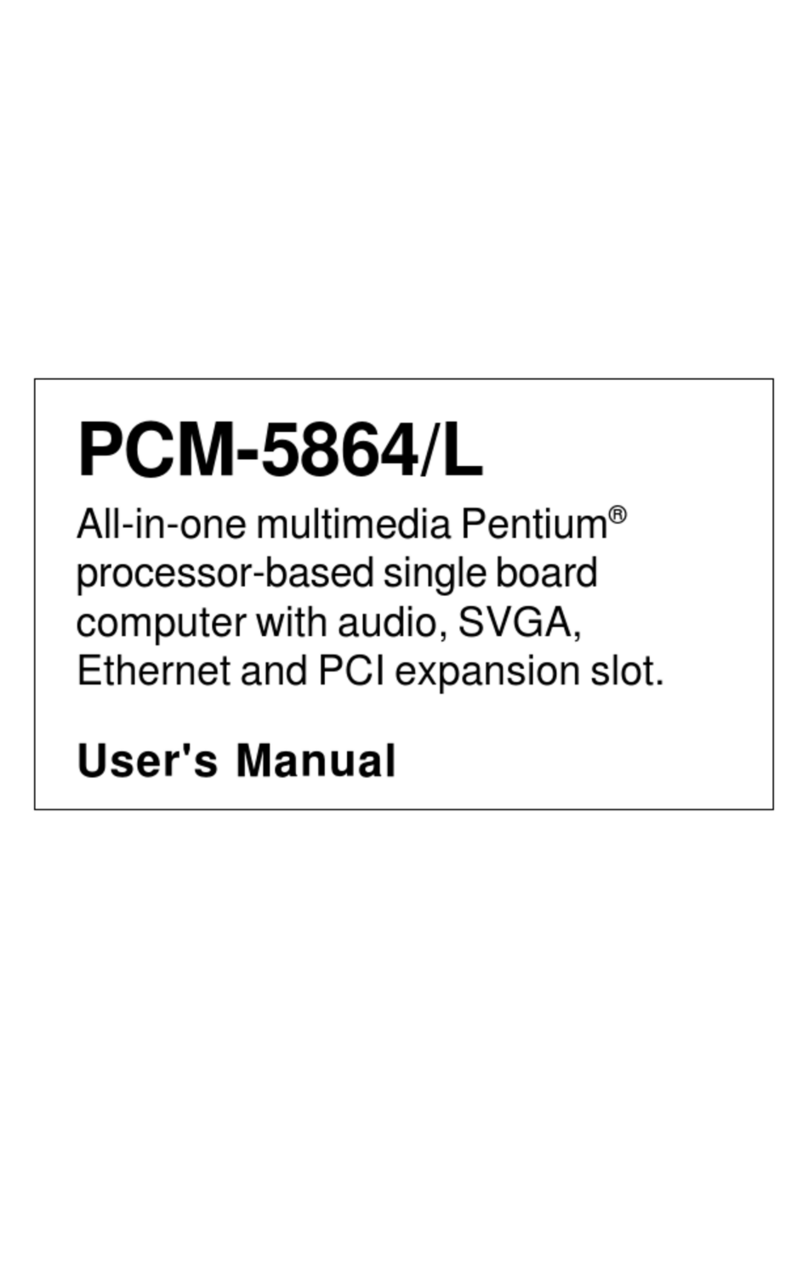
EMAC
EMAC PCM-5864 User manual

EMAC
EMAC SBC-675 User manual
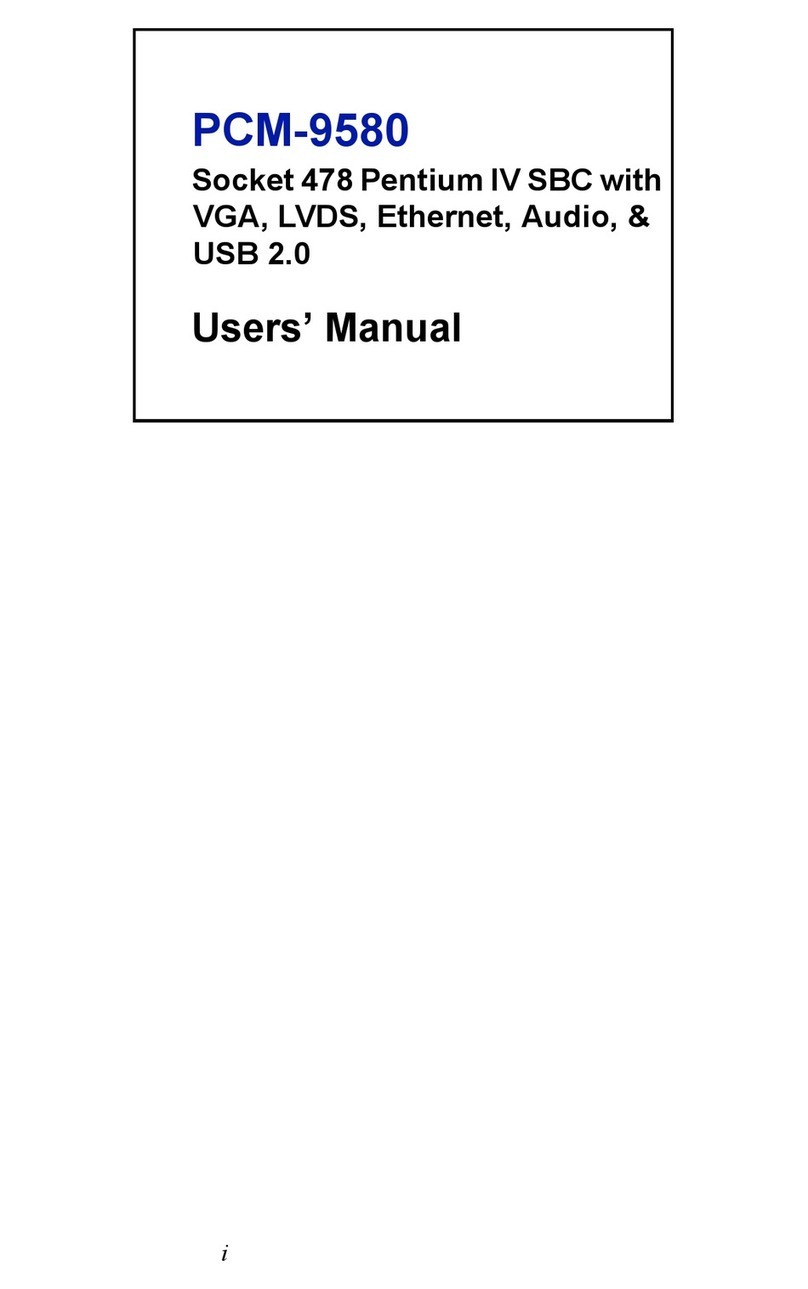
EMAC
EMAC PCM-9580F-00A1 User manual

EMAC
EMAC SBC-557 User manual
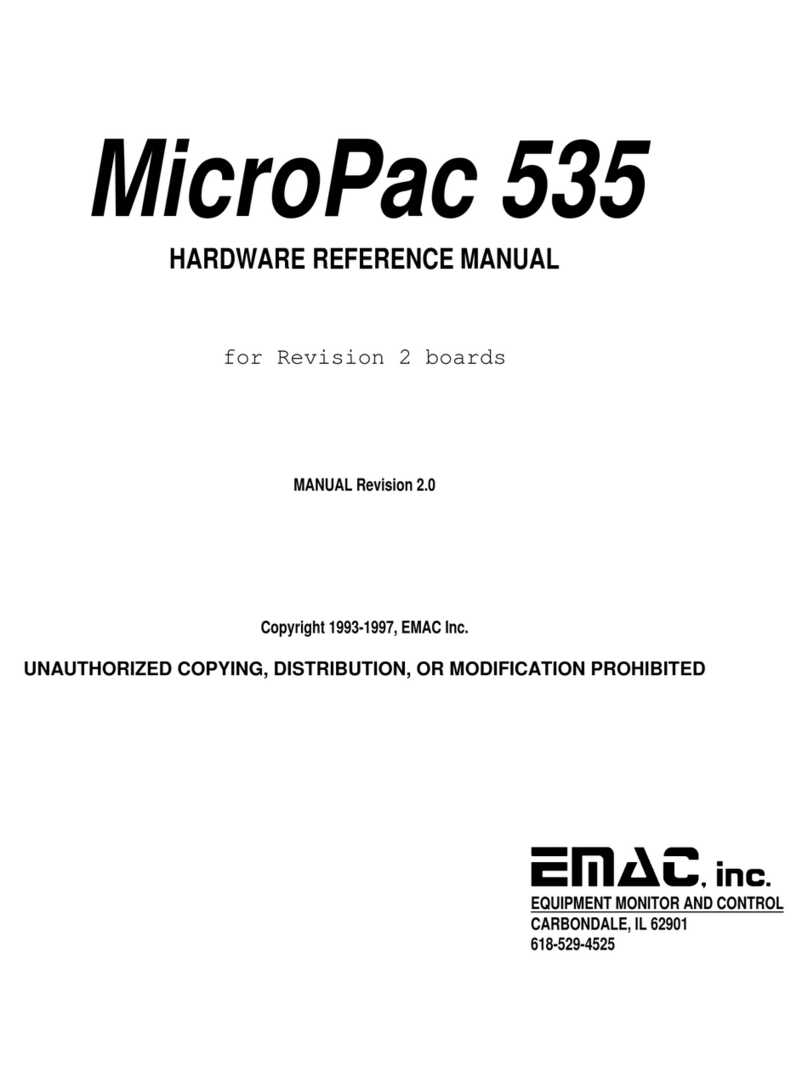
EMAC
EMAC MicroPac 535 Quick user guide
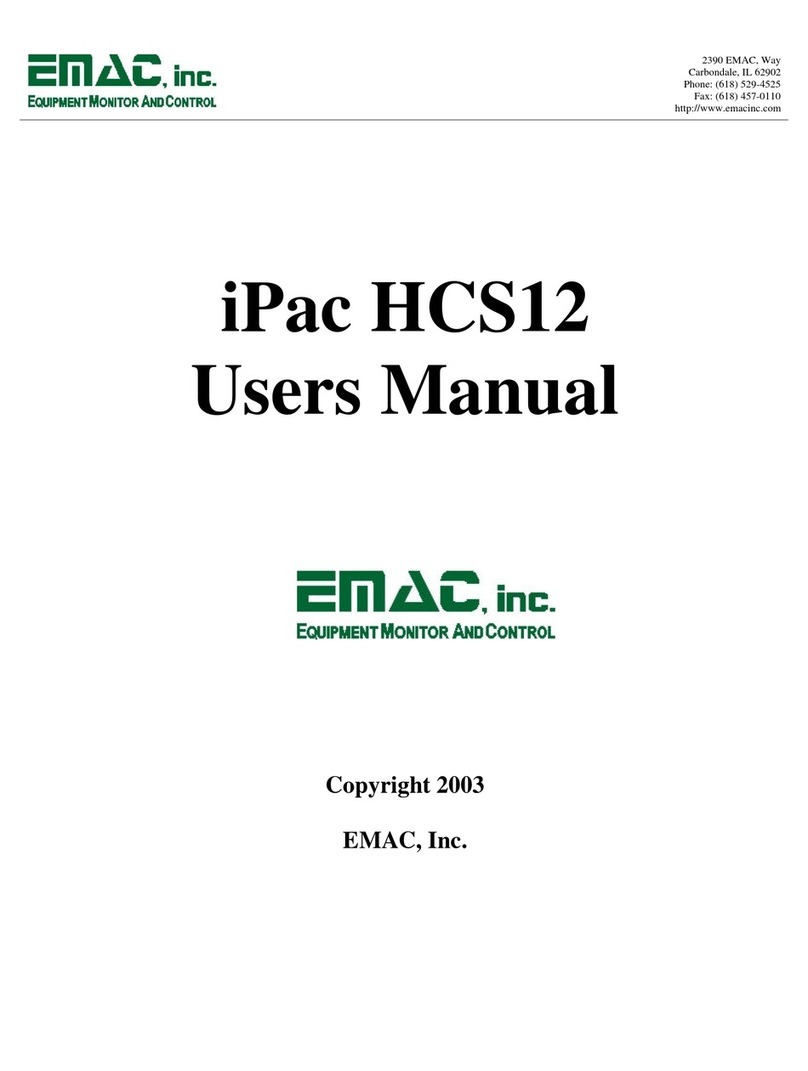
EMAC
EMAC iPac HCS12 User manual
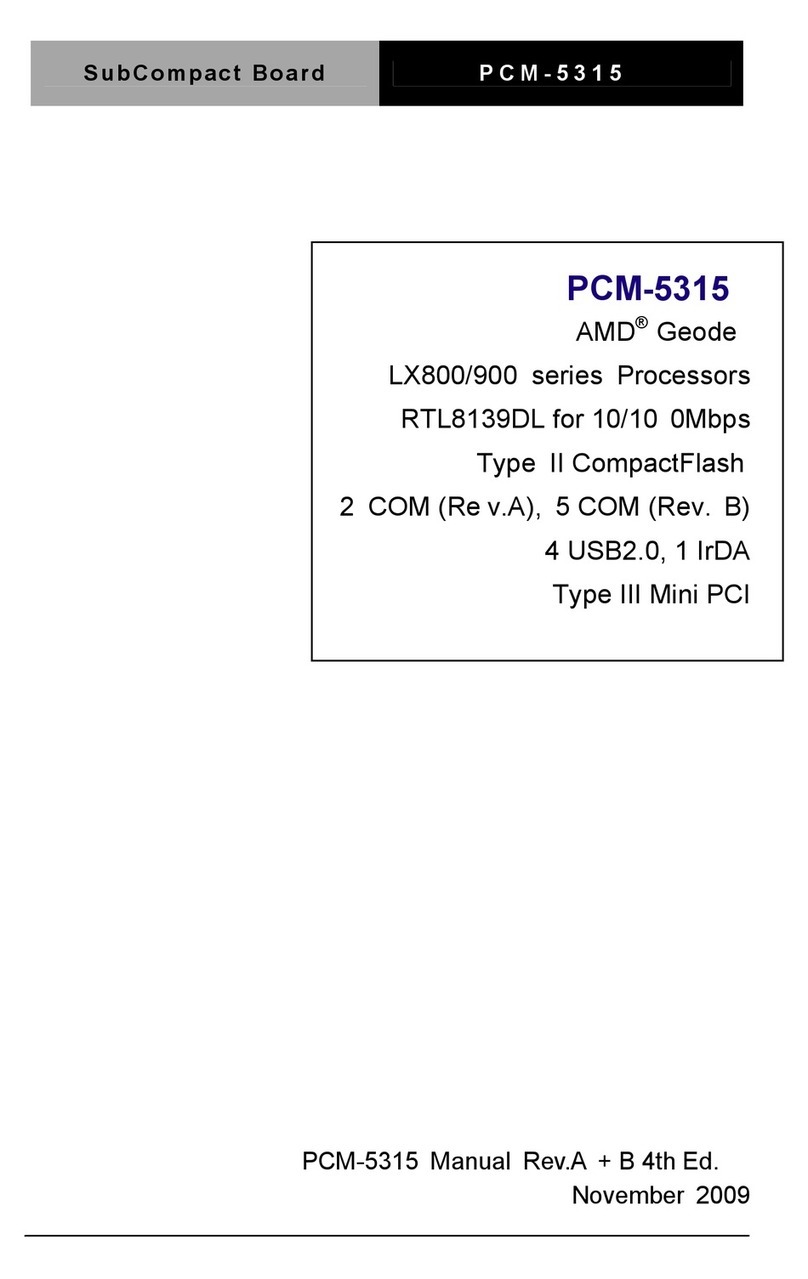
EMAC
EMAC PCM-5315 User manual
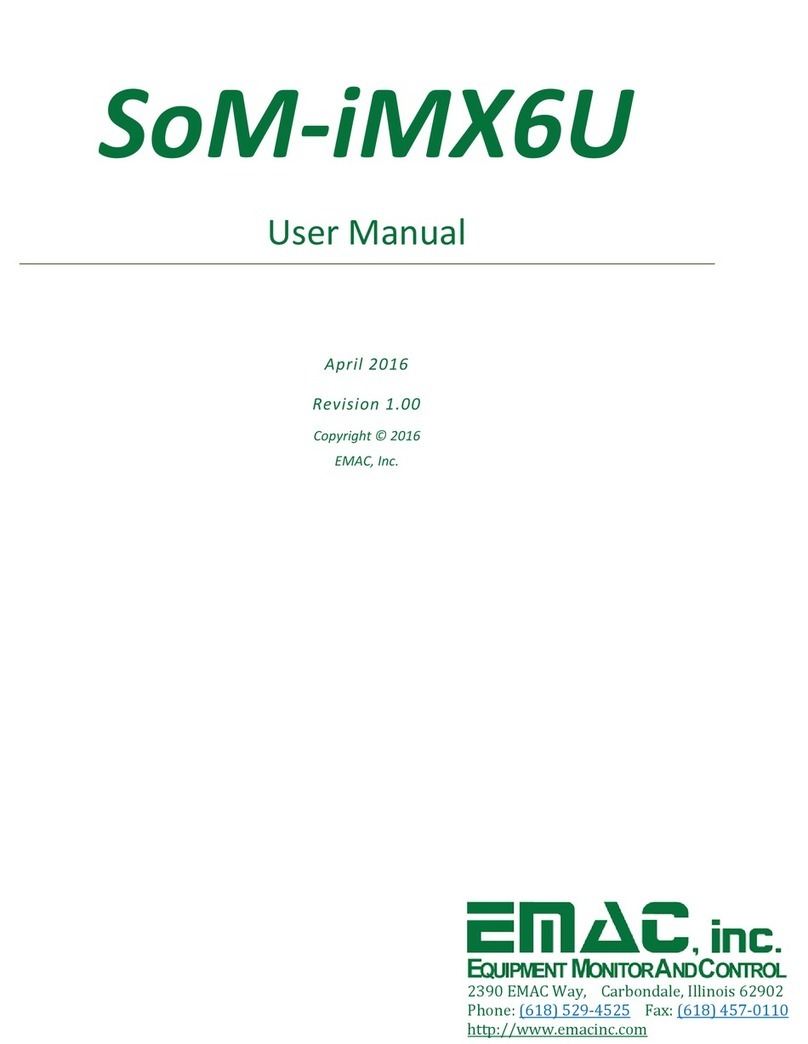
EMAC
EMAC SoM-iMX6U User manual
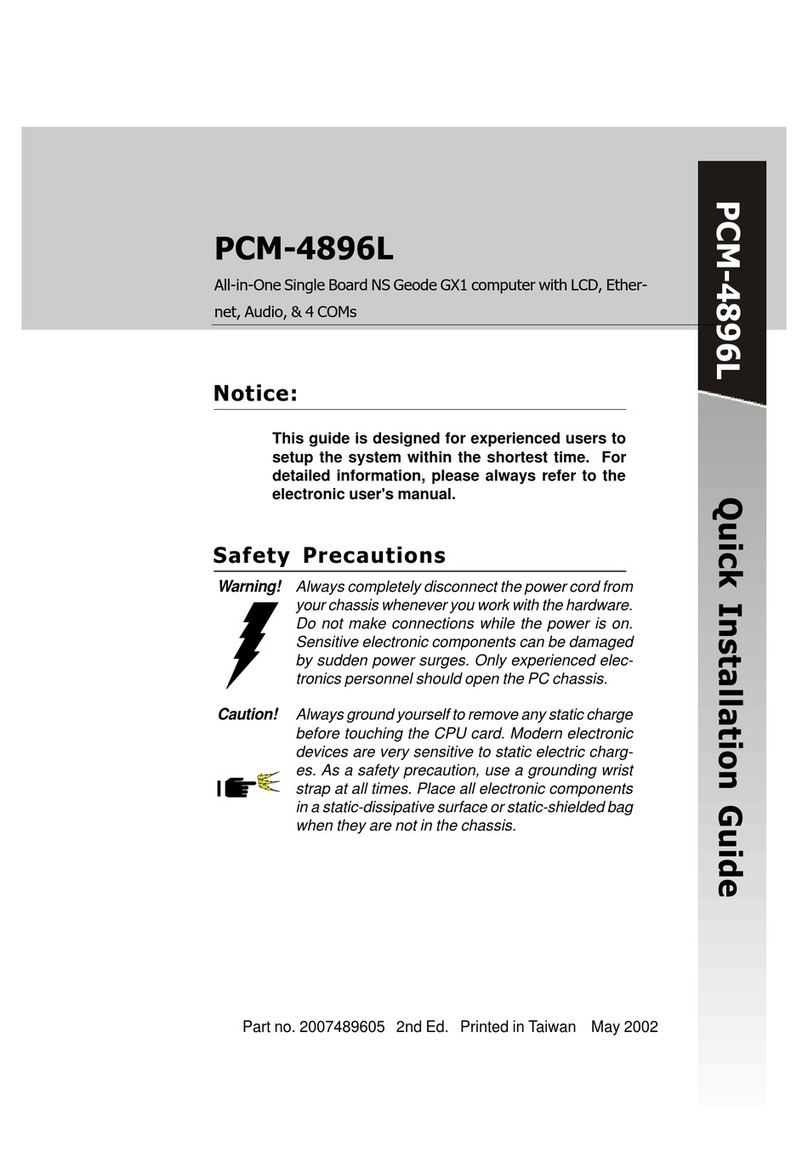
EMAC
EMAC PCM-4896L User manual
Popular Motherboard manuals by other brands
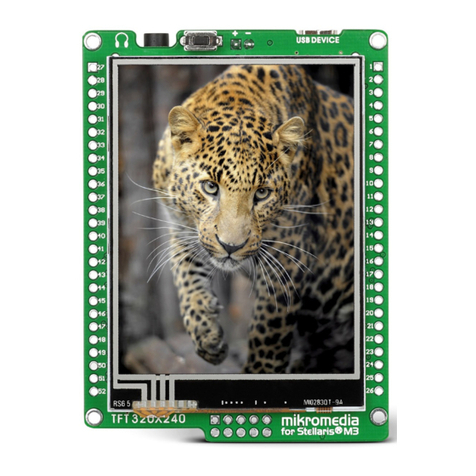
mikroElektronika
mikroElektronika mikromedia for Stellaris M3 user guide
Silicon Laboratories
Silicon Laboratories IRSLIDER2EK Si1142 user guide
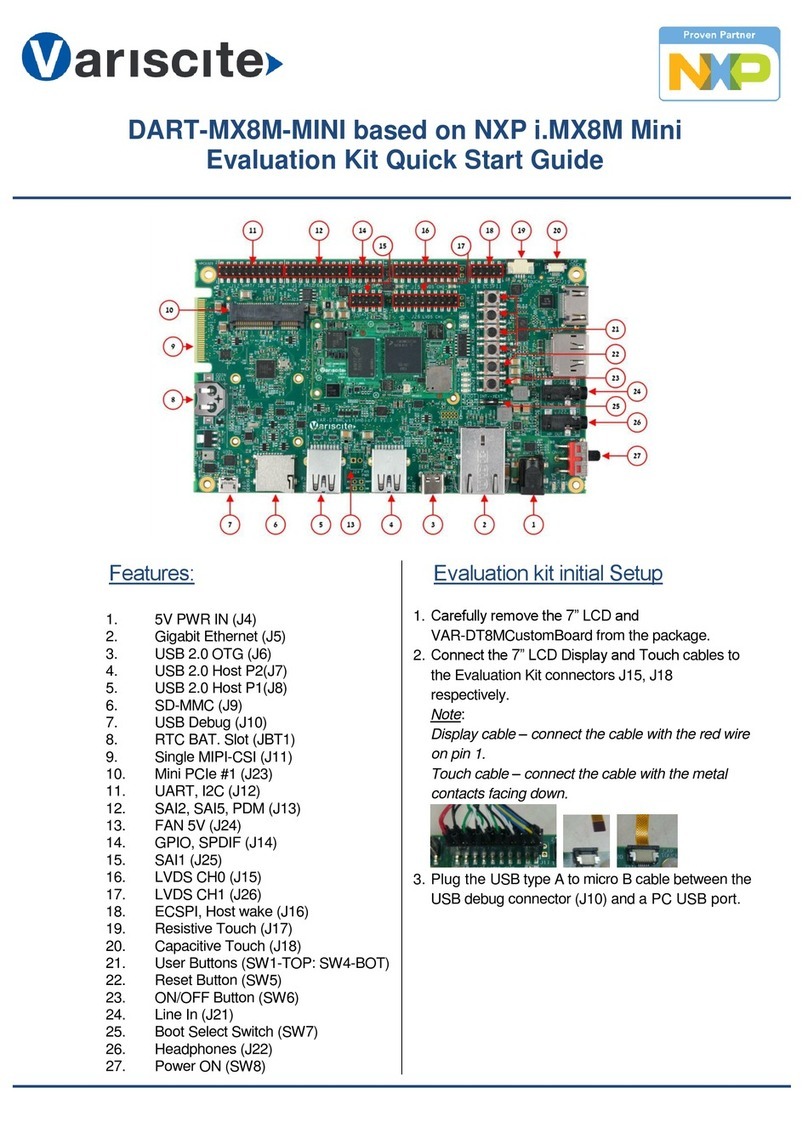
Variscite
Variscite DART-MX8M-MINI quick start guide
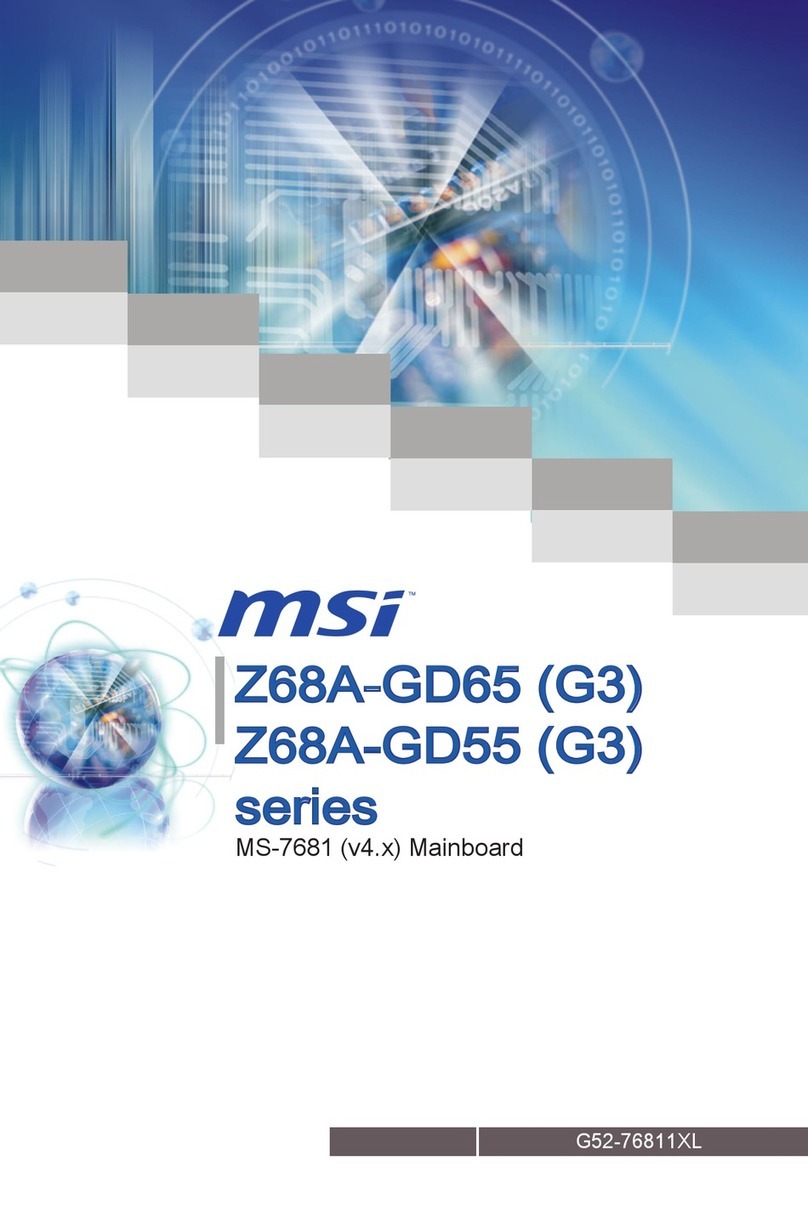
MSI
MSI Z68A-GD65 series manual
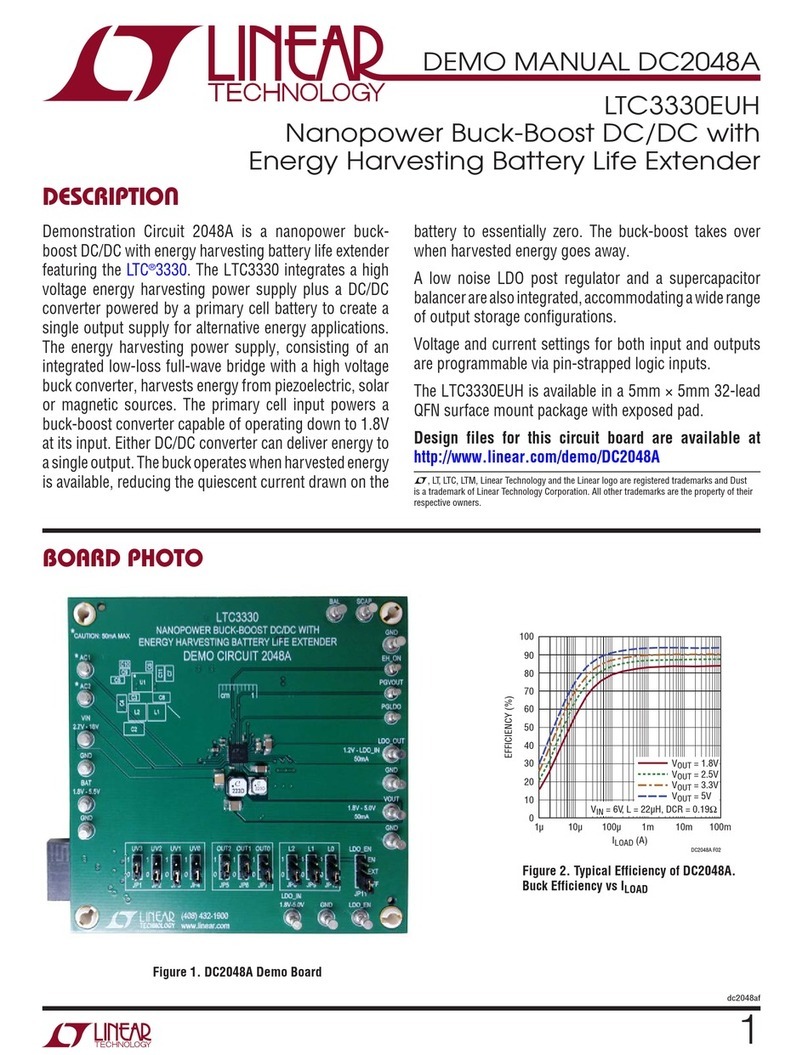
Linear
Linear DC2048A Demo Manual
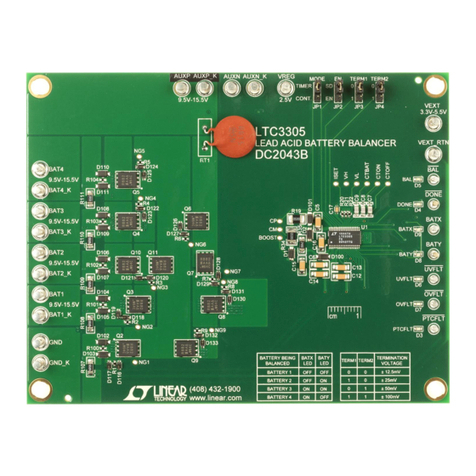
Linear Technology
Linear Technology DC2043B Demo Manual

